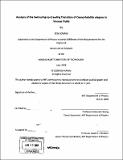| dc.contributor.advisor | Sebastian Seung. | en_US |
| dc.contributor.author | Kawai, Risa | en_US |
| dc.contributor.other | Massachusetts Institute of Technology. Dept. of Physics. | en_US |
| dc.date.accessioned | 2009-03-16T19:39:58Z | |
| dc.date.available | 2009-03-16T19:39:58Z | |
| dc.date.copyright | 2008 | en_US |
| dc.date.issued | 2008 | en_US |
| dc.identifier.uri | http://hdl.handle.net/1721.1/44763 | |
| dc.description | Thesis (S.B.)--Massachusetts Institute of Technology, Dept. of Physics, 2008. | en_US |
| dc.description | Includes bibliographical references (leaves 26-27). | en_US |
| dc.description.abstract | The locomotory behavior of the nematode Caenorhabditis elegans is often characterized by two distinct gaits - swimming when in fluids and crawling when on surfaces. Swimming is characterized by about a twice greater wavelength and about four time greater frequency of undulatory waves, compared with the crawling gait. These mechanisms which generate these gaits are not well-understood but have been suggested to be controlled by two separate neural circuits of central pattern generators. Here we studied the locomotion of young adult C. elegans in viscous fluids ranging from 0.001-1000 Pa s to determine whether there is a sharp or continuous transition between swimming and crawling. We characterized the locomotion by two parameters: the wavelength and the frequency of the undulating gaits. Our results for both parameters show a smooth transition, which suggests that there is only one neural circuit controlling forward locomotion which is modulated by the mechanical loading of the environment. | en_US |
| dc.description.statementofresponsibility | by Risa Kawai. | en_US |
| dc.format.extent | 27 leaves | en_US |
| dc.language.iso | eng | en_US |
| dc.publisher | Massachusetts Institute of Technology | en_US |
| dc.rights | M.I.T. theses are protected by
copyright. They may be viewed from this source for any purpose, but
reproduction or distribution in any format is prohibited without written
permission. See provided URL for inquiries about permission. | en_US |
| dc.rights.uri | http://dspace.mit.edu/handle/1721.1/7582 | en_US |
| dc.subject | Physics. | en_US |
| dc.title | Analysis of the swimming-to-crawling transition of Caenorhabditis elegans in viscous fluid | en_US |
| dc.type | Thesis | en_US |
| dc.description.degree | S.B. | en_US |
| dc.contributor.department | Massachusetts Institute of Technology. Department of Physics | |
| dc.identifier.oclc | 299138917 | en_US |
